本文
Ehime, "the country of Healing"
Ehime has the hot springs that will heal your body
Ehime has the nature that will quench your heart's desires
Ehime has the culture and history that will nourish your mind
Ehime has the food that will keep you in good health
Mt.Ishizuchi : Saijo City, Kuma Kogen Town
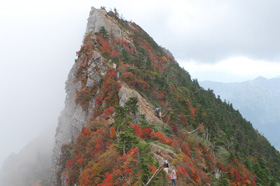
Mt. Ishizuchi is one of the Japanese seven sacred mountains, and through the ages has been known as the mountain of faith.
The Tuchigoya route is a relatively easy walk of about 4.6 km along a ridge path from Ishizuchi-tsiuchigoya. It takes about 2 and a half hours to the summit of the mountain.
At Ishizuchi Shrine Tsuchigoya Youhaiden, there are restaurants as well as accommodations.
Minetopia Besshi : Nihama City
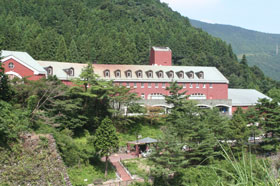
MineTopia Besshi in Niihama City is a theme park made in commemoration of the Besshi copper mine, which once was the world's top copper producer.
Visitors can explore the mysterious underground with a portable device that will explain the history of the mine as well as the future of copper mining.
Setouchi Shimanami Kaido : Imabari City
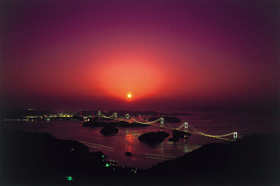
Shimanami Expressway (approximaTely 60 km long) is "the road that goes across the sea", with 10 bridges that connect Ehime Prefecture with Honshu Island (Onomichi City, Hiroshima Prefecture).
It goes through the islands that dot the Seto Inland Sea, which is often called the Aegean Sea of the East.
On this "Kaido expressway", bicycle and pedestrian paths have been included and are some of the first such paths in Japan to go over the sea. These paths enable people to stroll or bike while breathing in the bracing salt air.
Oyamazumi Shrine : Imabari City
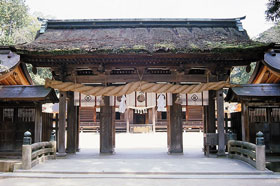
Located between Ehime and Hiroshima Prefectures, this shrine is known as housing the protectorate god of the sea from ancient times.
In buildings such as Shiyoden and Kokuhokan, important national treasures and cultural properties are displayed, such as full armor and swords that have been dedicated by warlords or imperial courts.
Shikoku Pilgrimage : Throughout Ehime
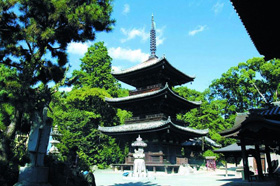
On Shikoku Island is the "Shikoku Pilgrimage: the 88 temples and the paths to pilgrimage", which the prefecture is aiming to have registered as a world heritage site.
The Shikoku Pilgrimage is a grand pilgrimage of about 1,400 km including 88 temples that are related to Kukai (Kobo Daishi: 774-835), the Buddhist monk who was the founder of the Shingon School.
At this time, 150,000 people per year follow the path of pilgrims, called "Ohenro-san (the pilgrims)", in their quest for healing. People in Ehime have the tradition of offering hospitality towards Ohenro-san, which makes Ehime the "home" of the heart of Japan.
Main Building of DOGO SPA : Matsuyama City
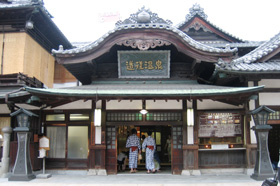
This building is the symbol of the Dogo Hot Spring - one of the oldest hot springs in Japan with a long and interesting history.
Since the three storied main building was built in 1894, the site has attracted many people, both from Japan and abroad. In 1994, it was designated as an important cultural property - the first time that a hot spring facility has received such a designation.
In the 7th century, poets as well as the royal family often visited the hot spring, and highly praised the quality of the hot spring's water. Since then, it has been the representative of Japanese hot springs.
To this day, it is also well known for the bathroom called "Yushinden" which is reserved for the exclusive use of the royal family.
Matsuyama Castle : Matsuyama City
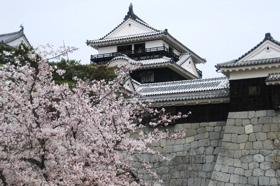
The castle is one of the three flatland-mountain castles that were built about 400 years ago.
It has been designated as an historic landmark and important cultural property.
In spring, it is well known as a beautiful cherry blossom viewing site, and is regarded as a popular recreation area.
Bansuisou : Matsuyama City
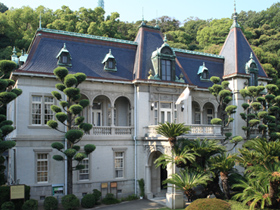
Bansuisou was built by the descendant of the former lord of Matsuyama, Sadakoto Hisamatsu, as his personal villa in 1922.
Hisamatsu had been stationed in France as an Army attache and he chose a French style building for his villa.
As the most famous social occasion at that time, Bansuisou was frequently visited by celebrities as well as members of the imperial family when visiting Ehime Prefecture. It is said that completion of the building had to be rushed as Prince Hirohito (later, Showa Emperor) was scheduled to visit Matsuyama.
Bansuisou survived the destruction of World War II and was designated as a cultural asset of Ehime Prefecture in 1985. It was also designated as an important national cultural property in 2011.
The building itself is artistic and is occasionally used as an exhibition gallery for paintings, hanging scrolls, and traditional art work. On the same site is Gudabutsuan, which is occasionally used for gatherings of haiku poets.
Tobe Pottery : Tobe Town
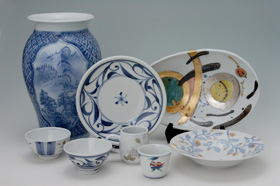
Tobe pottery has more than 200 years of history and has been designated as a national traditional craft, yet it is also used in daily life. Semitransparent indigo patterns drawn on the rather thickly constructed white porcelain is its signature style.
These days, young potters with their own studios and kilns are emerging. Female potters are also becoming more common. It is one of the most famous types of pottery, where tradition and innovation are being fused.
Oda-Myama Keikoku ravine : Uchiko Town
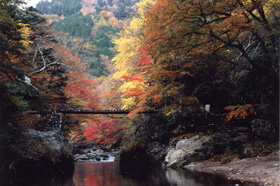
The walking path that goes along the valley is well known as a popular autumn color viewing site, where the clear surface of the river reflects the more than 20 different colors of the autumn tree leaves.
It is a 3 hour drive from Matsuyama and is one of the best places to be immersed in nature during any of the four seasons, with camping facilities, mountain stream fishing and skiing available.
Nanraku-en park : Uwajima City
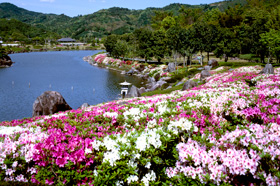
Nanrakuen is the largest circuit style Japanese garden in Shikoku. Visitors can walk around the pond and feel the Japanese atmosphere in the mountain teahouse, farm house, fishing house, and merchant’s house.
The Japanese water iris that blooms from May to June is of particular interest.










